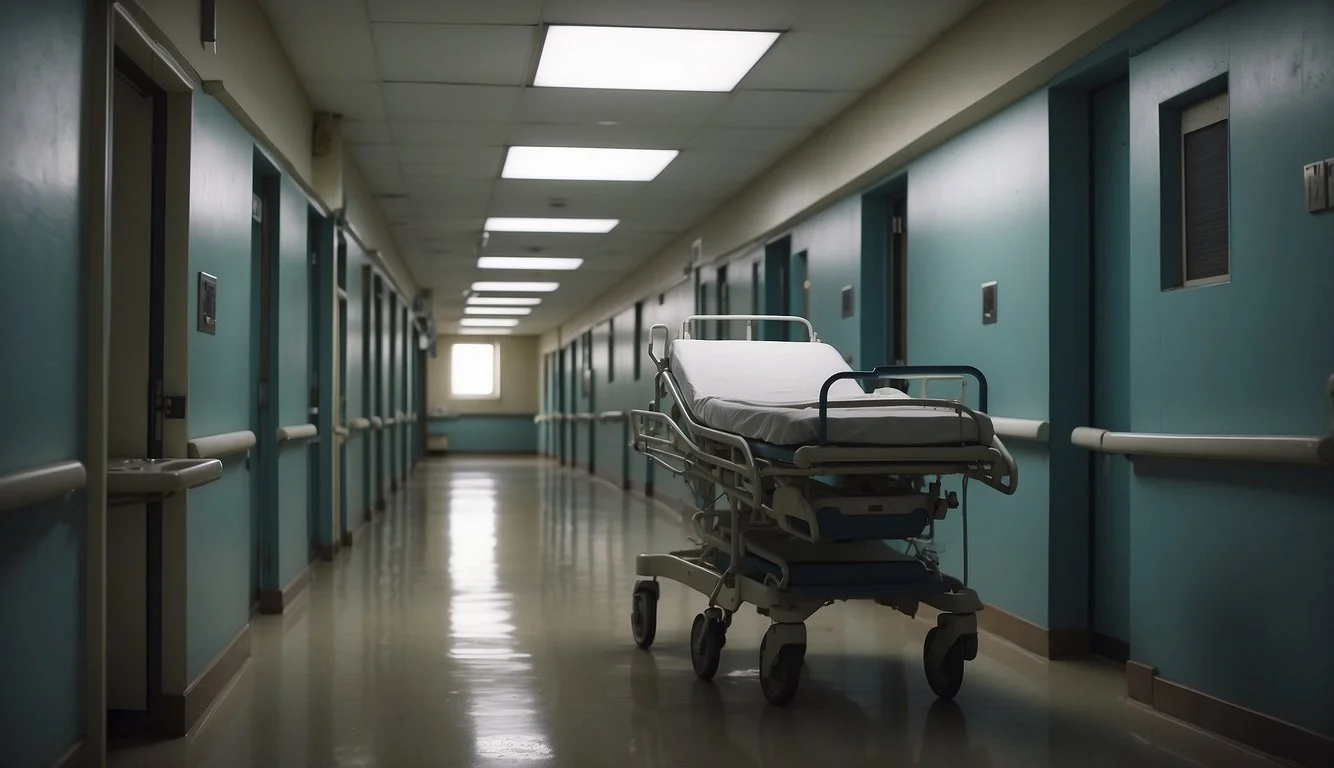Documentary Review: The First Wave (2021)
An In-Depth Analysis of Pandemic Responses
"The First Wave" (2021) is a harrowing and intimate documentary that captures the early horrors of the COVID-19 crisis in New York City. Directed by Matthew Heineman, this powerful film provides an on-the-ground view of the pandemic's initial impact on healthcare workers and patients. Viewers are taken inside Long Island Jewish Medical Center, experiencing firsthand the emotional and physical toll on those fighting the virus.
The documentary opens with deeply personal moments, such as a man saying goodbye to his wife over the phone before succumbing to the virus. These scenes offer a stark reminder of the high human cost during the pandemic's early days. By following caregivers and patients through their daily struggles, "The First Wave" presents an unfiltered look at the frontline battle against COVID-19.
Premiered at the 2021 Hamptons International Film Festival, this film has been lauded for its emotional power and relevance. By chronicling life inside a hospital when death seemed omnipresent, "The First Wave" serves as both a time capsule and a tribute to the resilience of healthcare workers.
Context and Relevance
"The First Wave" (2021) provides a gripping depiction of the early months of the COVID-19 pandemic, focusing on New York City's experience. It also highlights the significance of documentary filmmaking in capturing crucial historical moments.
COVID-19 Pandemic Background
COVID-19, caused by the SARS-CoV-2 virus, emerged in late 2019 and quickly escalated to a global health crisis by early 2020. As New York City became an epicenter, medical facilities faced unprecedented challenges. Hospitals were overwhelmed with patients, medical supplies were scarce, and frontline workers found themselves in perilous conditions.
The film covers the "first wave" from March to June 2020. This period was particularly harrowing, as everyday life halted, social distancing measures were enforced, and the mortality rate soared.
"The First Wave" captures this turmoil through personal narratives, highlighting the human impact behind the statistics.
Documentary Genre Significance
Documentaries hold a unique position in capturing real-life events and historical moments with authenticity and immediacy. "The First Wave" stands out for its raw and unfiltered portrayal of a city in crisis. The film provides an on-the-ground perspective, making the experience relatable and urgent.
Matthew Heineman, the director, uses his unprecedented access to offer an intimate view of the challenges faced by healthcare professionals. Through these stories, the documentary underscores the resilience and dedication of those on the frontlines, making it a significant contribution to the genre.
By centering the narratives of doctors, nurses, and patients, the film not only informs but also engages viewers on an emotional level, emphasizing the importance of documenting such critical events.
Synopsis of 'The First Wave'
"The First Wave" is a documentary that captures the early days of the COVID-19 pandemic in New York City. This film provides a detailed look at the experiences of medical professionals and their patients during this unprecedented health crisis.
Storyline Overview
The documentary begins in the spring of 2020, focusing on the initial outbreak of COVID-19 in New York City. It highlights the frantic atmosphere in hospitals as healthcare workers struggle to save lives amidst a flood of critically ill patients. The film portrays various moments of high tension and emotional exhaustion, showcasing the immense pressures faced by both staff and patients.
Scenes include medical personnel treating COVID-19 patients, the emotional toll of continuous exposure to the virus, and the resilience shown by those on the front lines. The documentary's opening scene, which shows a patient saying goodbye to his wife over the phone before passing away, sets a poignant tone for the rest of the film.
Key Characters and Profiles
The film features several key individuals, including Dr. Nathalie Dougé, a hospital internist whose personal and professional life is deeply impacted by the pandemic. Her experiences epitomize the dedication and struggle faced by many healthcare workers.
Another central figure is a COVID-19 patient whose journey from illness to recovery (or, in some cases, death) is meticulously documented. The inclusion of these personal stories provides an intimate look at the human impact of the pandemic.
Dr. Nathalie Dougé: A frontline physician balancing the demands of her job and personal life amidst the crisis.
Patient Profiles: Various patients with diverse backgrounds, each experiencing the ravages of COVID-19 in unique ways, providing a human face to the statistics.
Director's Vision and Approach
Matthew Heineman’s work on "The First Wave" provides a deeply immersive and poignant portrait of the COVID-19 pandemic's early months. His direction captures both the grand scale of the crisis and the intimate stories of those affected.
Matthew Heineman's Credentials
Matthew Heineman is a renowned documentary filmmaker known for his compelling storytelling and immersive style. He has received acclaim for films like "Cartel Land," which earned an Academy Award nomination, and "City of Ghosts," which won an Emmy. Heineman's reputation for capturing human resilience in extreme circumstances makes him particularly suited to delve into the chaotic environment of a hospital during the early COVID-19 outbreak.
His approach often involves gaining the trust of his subjects and spending significant time in their environments, which lends authenticity and depth to his narratives. With "The First Wave," Heineman continues this tradition, providing viewers with an unfiltered look at the frontlines of the pandemic.
Cinematic Style and Techniques
Heineman's cinematic style is characterized by its verité approach, where the camera subtly observes rather than intrudes. In "The First Wave," he employs handheld camera work that places viewers directly within the action, creating a sense of immediacy and immersion. This technique is essential in portraying the urgency and chaos in the hospitals.
Music plays a critical role, with compositions by H. Scott Salinas and Jon Batiste accentuating the emotional gravity of the scenes. Editing by Francisco Bello and others ensures that the narrative flows seamlessly, making the chaotic period comprehensible. Heineman’s use of tight close-ups captures the raw emotions of healthcare workers and patients, providing a human face to the pandemic's statistics.
Critical Analysis
"The First Wave" effectively captures the intensity and significance of the early COVID-19 crisis through its narrative structure, emotional storytelling, and technical prowess. This analysis breaks down the key elements that make the documentary a powerful piece of cinematography.
Narrative and Pacing
The film follows a structured narrative that provides an immersive look into the lives of healthcare workers and patients during the initial wave of COVID-19. Director Matthew Heineman crafts a compelling story without exaggeration, allowing events to unfold naturally. The pacing is deliberate, balancing between moments of calm and intense activity. This rhythm reflects the unpredictable nature of the pandemic and keeps the audience engaged.
The transitions between different story arcs are seamless, providing a coherent and fluid viewing experience. The documentary doesn't rush through scenes, offering adequate depth and context for each aspect of the narrative.
Emotional Impact and Audience Reception
"The First Wave" delivers a profound emotional impact, resonating deeply with viewers. Its unflinching portrayal of frontline workers' struggles and patients' suffering serves as a stark reminder of the pandemic's human cost. By focusing on personal stories, the film creates an intimate connection with the audience, making the broader implications of the pandemic more relatable and comprehensible.
Audience reactions highlight the documentary's success in evoking empathy and raising awareness. Many viewers commend its honesty and courage in showing the raw reality of the pandemic. Critics have praised the film for its sensitivity and authenticity, enhancing its credibility and reception.
Technical Execution
The technical aspects of "The First Wave" are executed with precision and care. Cinematography captures both the chaotic and quiet moments, using a mix of handheld and stationary shots to convey urgency and intimacy. Lighting is meticulously handled, often using natural light to enhance the realism of hospital scenes.
The sound design is equally impressive, meticulously capturing ambient sounds that add to the immersive experience. The editing is sharp, ensuring a coherent narrative flow while maintaining emotional tension. The use of music is understated but effective, complementing the visual storytelling without overwhelming it.
In summary, "The First Wave" stands out for its narrative coherence, emotional depth, and technical excellence, making it a significant documentary worthy of critical acclaim.
Themes and Messaging
"The First Wave" (2021) not only captures the initial surge of COVID-19 in New York but also reveals critical insights into the healthcare system and the extraordinary resilience and solidarity of the people involved.
Healthcare System Exposé
The documentary provides a gripping look at the healthcare system's tumultuous response to COVID-19. It places a spotlight on the immense pressure faced by hospitals, showcasing stories from doctors, nurses, and other medical staff who navigated unprecedented challenges.
By focusing on one of the hardest-hit hospital systems, it sheds light on systemic issues, such as resource shortages and the emotional toll on healthcare workers. The film vividly portrays the strain on the infrastructure and personnel, making clear the urgent need for healthcare reform and better preparedness.
Human Resilience and Solidarity
Amid the chaos, "The First Wave" emphasizes the extraordinary human spirit and resilience. It highlights personal stories of patients and medical staff, each displaying courage and compassion in the face of despair.
These narratives serve as a testament to the solidarity that emerged during the crisis, with individuals and communities coming together to support one another. Emotional highs and lows are sensitively captured, illustrating the strength derived from unity and collective effort. The film underscores how, even during the darkest times, human connections and perseverance can prevail.
Interviews and Real-life Accounts
The documentary "The First Wave" features firsthand testimonies from frontline workers and intimate conversations with patients and their families, offering a raw and powerful look into the early stages of the COVID-19 pandemic in New York City.
Frontline Workers' Testimonies
Frontline workers, including nurses, doctors, and administrators, share their intense experiences fighting COVID-19. Dr. Nathalie Dougé, for example, provides a poignant account of the relentless battles faced every day.
These testimonies highlight the emotional and physical toll on the medical staff, bringing attention to the profound stress and grief they endured. Such interviews are crucial in giving a human face to the toll the pandemic took on healthcare workers, their resilience, and the solidarity among health teams.
Patients and Families' Perspectives
The documentary also captures the moving stories of patients and their families. It includes scenes of patients saying emotional goodbyes over the telephone, underscoring the isolation and tragedy of the COVID-19 crisis.
Family members recount their experiences dealing with the sudden hospitalization and loss of loved ones. These interviews provide a stark contrast to the clinical environment, illustrating the personal and deeply human impact of the pandemic.
Cultural and Societal Impact
The documentary "The First Wave" offers a raw depiction of the COVID-19 pandemic’s early days. It has significantly shaped public perception and influenced documentary filmmaking approaches.
Influence on Public Perception of the Pandemic
"The First Wave" brings the initial chaos and emotional weight of the pandemic into sharp focus. By highlighting personal stories of patients and medical staff, it humanizes the often abstract statistics and news reports. This helped the public relate to the suffering and sacrifice involved.
The film's intimate portrayal of hospital settings during the crisis provided a stark reminder of the virus's severity. It amplified public awareness about the realities faced by frontline workers and COVID-19's impact on vulnerable communities. Such representations have fostered empathy and a deeper public understanding of the health challenges posed by the pandemic.
Contribution to Documentary Filmmaking
Matthew Heineman’s work on "The First Wave" has set a new standard in documentary filmmaking. Using real-time footage and an immersive approach, the film captures unfiltered moments within New York City hospitals. The candid and unmediated style adds a layer of authenticity, compelling viewers to acknowledge the harsh realities.
The collaboration of editors Francisco Bello, Gabriel Rhodes, and others ensured the documentary’s narrative maintained emotional intensity without sensationalism. This method has influenced how documentaries approach real-life crises, emphasizing the importance of present-time documentation and empathetic storytelling. "The First Wave" therefore contributes not just as a historical record but as a model for future filmmakers.
Production Value
The documentary "The First Wave" boasts remarkable production quality, synthesizing powerful visuals and a resonant soundtrack to capture the intense experiences of healthcare workers and patients during the early days of the COVID-19 pandemic.
Cinematography and Visuals
Directed by Matthew Heineman, the documentary employs a cinéma vérité style, emphasizing raw and unfiltered footage. The use of handheld cameras creates an immediacy, immersing viewers directly in the hospitals of New York City. Each shot is meticulously framed to highlight the emotional weight of the moment—whether it’s the tension in a healthcare worker’s face or the quiet devastation of an empty corridor.
The lighting, natural and ambient, avoids artificial enhancement, lending a gritty realism to the scenes. The choice to shoot in high definition ensures that intricate details, such as the strain on medical equipment and the exhaustion etched into the faces of doctors and nurses, are captured with clarity. This approach not only provides an intimate look at the pandemic’s impact but also underscores the relentless environment within which these heroes operate.
Soundtrack and Scoring
The soundtrack and score of "The First Wave" are essential components of its emotional landscape. Original composition by Jordan Gagne combines orchestral elements with minimalistic electronic tones, creating a poignant backdrop that enhances the narrative without overwhelming it. Subtle yet powerful, the music ebbs and flows with the documentary’s pacing, punctuating moments of hope and despair.
Ambient sounds—such as the beeping of medical monitors, the hushed conversations in hallways, and the distant sirens—are masterfully integrated to maintain an immersive experience. The sound design ensures that each auditory element contributes to the storytelling, reflecting the chaos and heartbreak of the pandemic while allowing for moments of quiet reflection.
Concluding Remarks
"The First Wave" (2021) provides a visceral and intimate look at the early days of the COVID-19 pandemic. Directed by Matthew Heineman, the documentary takes viewers inside a New York City hospital, immersing them in the chaos and emotional toll experienced by healthcare professionals and patients.
The film captures raw moments of despair and resilience. Scenes of doctors and nurses under extreme pressure highlight their dedication and the overwhelming challenges they faced.
Critical responses emphasize its emotional power. Variety describes it as a "courageous cinematic time capsule," while other reviews note its harrowing depiction of hospital life during a global crisis.
"The First Wave" serves as an important historical document. It reminds viewers of the personal and collective struggles during an unprecedented time.
For those seeking a heartfelt and unflinching portrayal of the pandemic's impact, this documentary proves essential viewing.







